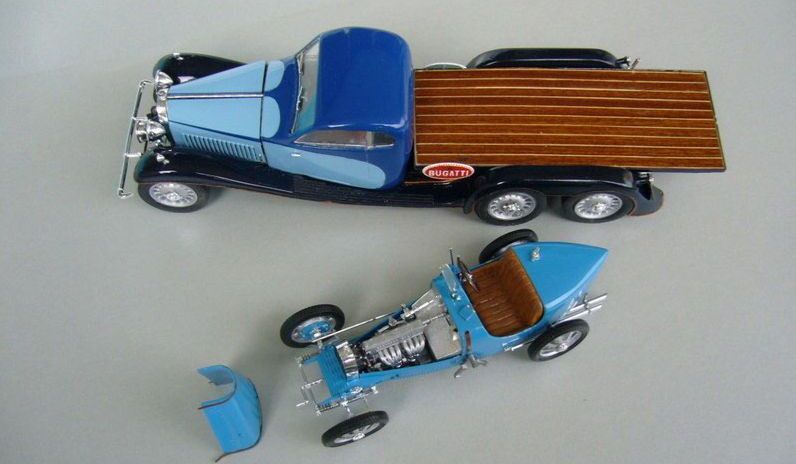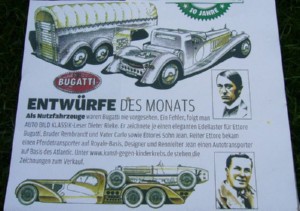

Editor: Jaap Horst

Actually, the article consists of 3 parts:
Bugatti AutoRail Miniature, built in Japanby Unknown, 1:32 scale It does not state on the page where I found this wonderful construction, what the exact scale is. However, judging from the size compared with other objects in the photographs, I'm quite sure that it is 1-gauge, or 1:32. Also, I can not find a name....
Comment from the builder, as read on the website: A driver's cab such as the belvedere rises in the roof center of the middle vehicle highly. The first car and the third car become the streamlined design and are large-scale autorail which becomes 60 meters in total length. Four engines put in both sides of the middle car center drives the 2 inside axles of each bogie. The drive from the engine is carried out by a flexible shaft. Even the model reproduces this flexible shaft. But the power drive from a motor is carried out for only one chassis. This model run smoothly because I inserted ball bearings in all bearings . Glass of 2mm thickness is used for windows. This is good for clearness and strength.
There was no special referral policy, but we started with the idea of drastically improving the connection method of at least 3 units, enhancing the lighting, and making the interior structure even more elaborate.
Improved coupler
I wanted to connect the car body so that it could be easily connected and disconnected.
Of the two sides, one side is made is in such a wat that, when the one side is inserted from the right, the spring-shaped side opens.
To release it, pry it diagonally like this to release the pin from the hole.
Intermediate body in the room detail, improvement of lighting
In addition, I decided to add a bicycle to my luggage for the purpose of adding decoration.
I have never made a bicycle, but I soldered it to orthodox with brass to make it like this. The gentleman on the left is the conductor in the conductor room.
The blank area in the center is the engine room for installing four ROYAL engines, the famous Bugatti car. I'd like to make a miniature, but I did not put these in, because it's invisible from the outside.
Described on December 12, 2011
The tail light is also clear with a red LED. It was difficult to remove the original incandescent bulb, but it was refreshing after 11 years.
Taken in March 2010 It is difficult to put power in a 4-axis bogie. The two axes in the center are dummy. Only the two axes at both ends are transmitted from the pinion to the crown, and are supported at three points. Of course, it comes with ball bearings. The sight of all three articulated vehicles and four-axle bogies is strange.
Model making record:
The AutoRail was shown at a model exhibition demonstration at a lecture entitled "Royal on Rails" held on February 19, original source; with more info (in Japanese) , Google Translate version

Bugatti Type 50 Race-transporter by Günther Eberhardt, 1:24 scale
by Günther Eberhardt, 1:24 scale
Possibility fiction Bugatti The idea came from Dieter Rieke, a designer, artist and architect. A car newspaper offered drawings to be bought for a good cause. More about this on a separate article in this issue of the Bugatti Revue.
What if Bugatti had also built commercial vehicles?
The original blueprint also has a special feature. A chassis without a body is shown there, with the hint that some
Franklin also had an Atalante and Burago an Atlantic. Both made of metal, which would have made it much more difficult to cut - but both struck me as too delicate as a transporter base. According to the drawing, the loading area should be
The frame was lengthened by 25 mm by sawing through parts of the frame at different points and gluing them together. In addition, the second rear frame was added. After the offset for the rear axle mount, the frame widened by 6 mm on each side. The axles also grew by 6 mm on each side. In the original, the half-axles are flanged to the differential / gearbox. The widening succeeded elegantly and credibly with the sockets (6 mm) made. In this way, the original suspension and quarter-elliptic springs could be retained. Of course, the cardan shaft and the exhaust also had to be lengthened.
The loading area substructure consists of drilled evergreen U-profiles and evergreen stripes. A work to drive you crazy because of the 1000 holes. I wanted a boat deck made of mahogany and ramin wood slats like on a yacht. The wood is available in ship model building supplies. Under the loading area there is a slot for the loading ramps and the spare wheel. The car is standard up to the A-pillar. I absolutely didn't like Heller's solution for the bonnet. Therefore, in order to be able to unfold it prototypically, I shortened a bonnet hinge tape from a slaughtered Bugatti Royale by Franklin Mint to the required length and glued it with Stabilit Express. The bonnet side parts fold inwards as it should, thanks to self-made joints made from pin bolts. The eternally long fenders have also been lengthened using the cut-through method and elegantly merge with the rear fenders, which consist of all the originals and this and that divided into thirds.
The effort involved in the whole thing is difficult to describe in words. Was it worth all the effort? For a fiction? I think so, because there is nothing original and only 3-dimensional can you see exactly what would have happened if? Models, text and images: Günther Eberhardt, Munich

Bugatti T57 Aerolitheby Nik Levecque, 1:24 scale
It was a blinding car with a futuristic design, designed by Jean Bugatti who had taken over the management of the factory in Molsheim at that time. The body was made of ‘Elektron’, a metal alloy that was 98% magnesium. This material was without light, but also very difficult to process. Based on the Aérolithe, only 3 (maybe 4) series cars were built, the famous 57S Atlantic types, all three (two) of which are still preserved.
In 2013, the Canadian car restorer ‘The Guild of Automotive restorers’ managed an incredible job by bringing this 1935 prototype back to life, based on an original Bugatti chassis and the preserved photos…. Among other things, they used ten sheets of 120x240cm magnesium, each costing $ 3,000; the total value will certainly be in the millions of €.
There is no model construction box here, but a Burago toy car on a scale of 1/24, which I thoroughly adapted. So the process was reversed: I made the series car the prototype. The car is about 22cm long. Special features were:
On the right: the original Burago model and the Aérolithe. |